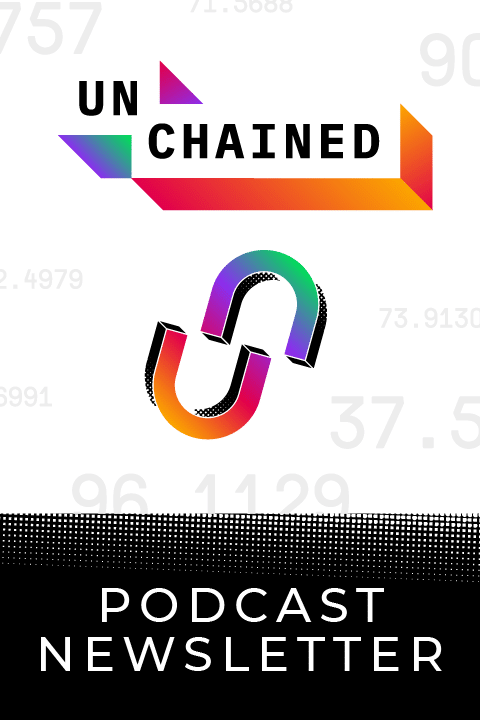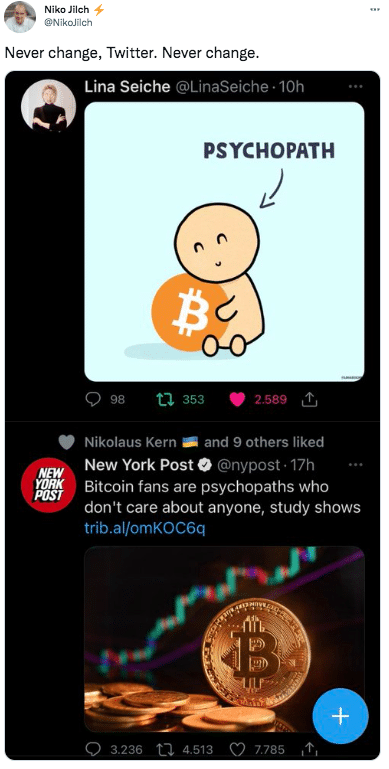April 14, 2022 / Unchained Daily / Laura Shin
Daily Bits ✍️✍️✍️
-
Tether is set to reduce holdings of commercial debt in its reserves.
-
Maple Finance is planning a partnership with MakerDAO to help the protocol hold assets with a low correlation to the crypto market.
-
Anchor is set to launch on Polkadot’s Acala.
-
Nexo unveiled a credit card that allows users to spend without selling digital assets.
- The Ronin exploiter has moved 21,000 ETH into Tornado Cash.
Today in Crypto Adoption…
-
BlackRock is studying the crypto sector.
-
The Dallas Cowboys inked a partnership deal with Blockchain.com.
-
Socios, a fan-token platform, signed 13 NFL teams.
-
Wikimedia, a major contributor to Wikipedia, has requestedthat Wikipedia stop accepting crypto donations.
The $$$ Corner…
-
Context, a web3 social app, raised $19.5 million in a seed round led by Variant Fund.
-
Loop raised $4 million in a seed round led by a16z.
- Dfns, a crypto password protection firm, raised $13.5 million in seed funding.
What Do You Meme?
What’s Poppin’?
The Merge Isn’t Coming Soon
The Ethereum merge, where the blockchain’s proof-of-work consensus algorithm will transition to proof-of-stake, has been delayed from an estimated June launch to the second half of 2022.
The assessment was made by the Ethereum Foundation’s Tim Beiko via Twitter. “It won’t be June, but likely in the few months after. No firm date yet, but we’re definitely in the final chapter of PoW on Ethereum.” In the same thread, Beiko added that he “would _strongly_ suggest not investing more in mining equipment at this point.”
Delays are the name of the game for Ethereum. For example, the transition from PoW to PoS, or ETH 2.0, has been teased since early 2020.
Ethereum researchers have recently been putting the network through various “shadow fork” tests. These forks allow developers to break a small section of nodes away from Ethereum into a new devnet to give researchers a more realistic environment to test The Merge compared to testnets.
“Inheriting the state of existing testnets allows us to stress test our sync assumptions as well as assumptions around how long it takes to build a block/timeouts,” explained Ethereum dev Parithosh Jayanthi. “Since we stay connected to the peers on the canonical chain, we import some of their transaction gossip as well,” he added.
Previously, only testnets had been shadow forked. Parithosh reported that by April 10th, Ethereum researchers performed three shadow forks of Goerli that included bugs. However, on April 11th, Ethereum’s mainnet underwent a shadow fork for the first time.
Based on analysis by Ethereum developer Marius van der Wijden, the April 11th mainnet shadow fork was successful. He wrote, “BTW, the mainnet shadow fork was a huge success!” However, he clarified, two Ethereum clients, Nethermind and Besu, “stopped at the transition, but a fix is being deployed for Nethermind that allows them to sync up.” Two other Ethereum clients, Geth and Erigon, reportedly progressed “happily” through the shadow fork. (Over 93% of Ethereum nodes are use Geth, Erigon, Nethermind, or Besu clients.)
For Ethereum’s merge to go through, the shadow forks and testnets need to experience the merge with absolutely no bugs, wrote Tim Beiko. The Merge “date will only be set once client teams are confident that the software implementations have been thoroughly tested and are bug-free,” Beiko explained on Github.
Recommended Reads
-
Swan Bitcoin’s Brandon Quittem on Bitcoin as a pioneer species:
-
Oris Dorch on assets trapped in the Waves ecosystem:
-
@Route2Fi on crypto market lessons:
On The Pod…
Excited About Your Bored Ape or CryptoPunk? Make Sure You Understand Your IP Rights
Stuart Levi, co-head of the Technology Transaction and Intellectual Property Group at Skadden Arps, and Marta Belcher, general counsel and Head of Policy at Protocol Labs, break down the legal issues surrounding NFTs specifically in the context of Yuga Labs’ recent purchase of CryptoPunks and Meebits IP rights. Show highlights:
-
the definitions and differences between copyrights, trademarks, and rights of publicity (name, image, likeness)
-
how NFT projects have evolved in the past 12-18 months and what that means for the rights of NFT holders
-
why NBA Top Shot’s licensing model is the best model for famous brands entering the NFT space
-
how the popularity of PFPs and the open-source ethos of crypto has led to confusion regarding the commercial rights of NFT holders
-
what you are getting when you buy an NFT (hint, it’s not copyright)
-
the misconceptions surrounding Yuga Labs’ acquisition of CryptoPunks and Meebits
-
why Bored Ape Yacht Club NFT holders most likely cannot use the Bored Ape Yacht Club brand or logo
-
what issues web3 projects face in getting NFT holders to accept terms and conditions
-
why web3 projects should protect their trademark
-
what a Creative Commons license is, and how it can be used in the NFT space
-
what sort of licenses exist in the NFT space
-
why secondary sales and transfers of NFTs pose such massive problems for copyright and trademark owners
-
how marketplaces are handling terms and conditions
-
what NFT projects can do to help the transfer of copyrights and trademarks
Book Update
My book, The Cryptopians: Idealism, Greed, Lies, and the Making of the First Big Cryptocurrency Craze, which is all about Ethereum and the 2017 ICO mania, is now available!
You can purchase it here: http://bit.ly/cryptopians




